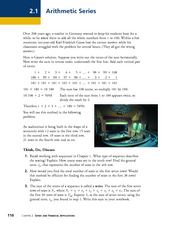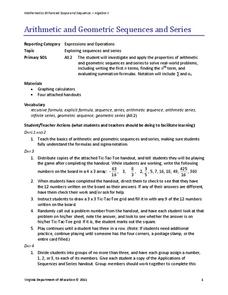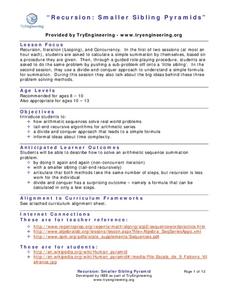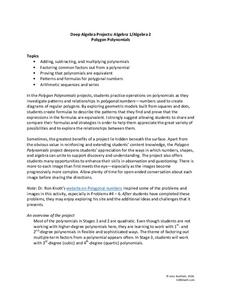CK-12 Foundation
Arithmetic Series Sums: Adding Arithmetic Sums
Sum up the shortcuts. The interactive allows pupils to discover a shortcut in finding a partial sum of an arithmetic series. Learners use the shortcut to find other sums and to verify the process.
West Contra Costa Unified School District
Arithmetic Series
Fall for a series. Learners determine how to find out how far a skydiver falls in the first 20 seconds. The Algebra II lesson introduces the idea of adding up the terms of an arithmetic sequence. Pupils learn how to use Sigma notation to...
Flipped Math
Series
Add it all together. Pupils learn how Gauss was able to add the numbers from 1 to 100 so quickly and arrive at a formula to find the sum of a given number of terms of an arithmetic series. Scholars learn the formula to find the sum for a...
Curated OER
Sum of an Arithmetic Series
In this algebra worksheet, students are asked to add up the integers from 1 to 100. They use Gauss method to find the sum of this arithmetic series. There is an answer key with this problem.
Curated OER
2.1 Arithmetic Series
In this arithmetic series worksheet, students solve 30 short answer problems. Students find the sum of a given arithmetic series. Students find arithmetic means between two terms in an arithmetic sequence.
CK-12 Foundation
Sums of Finite Arithmetic Series: Triangular Numbers
Using a slider, scholars build triangular numbers and their associated rectangles and use the geometric display to find the pattern to determine the next triangular number. They then relate that number to the area of the rectangle to...
College Board
AP® Calculus: Special Focus - Infinite Series
Read a series to develop an understanding of series. The special focus professional development on infinite series consists of eight articles. Articles contain information strictly for teachers along with aspects to incorporate into the...
Curated OER
Series Review Sheet
Save an infinite amount of time and enjoy this pre-made series formula guide. Arithmetic and geometric formulas are all included as well as Pascal's Triangle and examples of how the Binomial Theorem expands.
Curated OER
Arithmetic Series
For this arithmetic series worksheet, students solve and complete 26 various types of problems. First, they evaluate the related series of each sequence shown. Then, students determine the number of terms n in each arithmetic series.
Curated OER
Arithmetic Series
In this arithmetic series worksheet, students identify the first three terms in a given arithmetic series and find the sum of an arithmetic series. This two-page worksheet contains 18 problems.
Virginia Department of Education
Arithmetic and Geometric Sequences and Series
Examine the importance of sequence and series through contextual situations. Here, learners partake in a five-day unit that begins with the basics of arithmetic and geometric sequences and series. As it progresses, pupils apply the...
Curated OER
Arithmetic or Geometric Series
In this Algebra II/Trigonometry activity, 11th graders evaluate arithmetic and geometric series. The two page activity contains ten multiple-choice problems. Answers provided.
Curated OER
Trigonometry Practice Series #3
In this trigonometry worksheet, students calculate the sum of the terms in an arithmetic and geometric series. This two-page worksheet contains 5 multi-step problems. Answers are provided at the bottom of the page.
Curated OER
Arithmetic Sequences
Find the sequence of an equation with your math super stars. They differentiate between arithmetic and geometric sequences and then calculate the sum of finite and infinite sequences.
Curated OER
Arithmetic and Geometric Series
In this algebra instructional activity, students calculate the sum of a finite, geometric or arithmetic series. There are 5 multiple choice questions.
Curated OER
Arithmetic Series, Geometric Series, Partial Sums of Geometric Series
In this Algebra II/Pre-calculus worksheet, students solve problems that involve arithmetic series and infinite geometric. Students determine the partial sums of a geometric series. The three page worksheet contains forty-six...
EngageNY
The Geometric Effect of Some Complex Arithmetic 2
The 10th lesson in a series of 32, continues with the geometry of arithmetic of complex numbers focusing on multiplication. Class members find the effects of multiplying a complex number by a real number, an imaginary number, and another...
101 Questions
Super Stairs
Keep your classes climbing in the right direction. Young mathematicians collect data from a video presentation. Using their data, they build an arithmetic sequence and use it to make predictions.
Curated OER
Geometric Series 2.3
Students will determine if a series of numbers are geometric, arithmetic, or neither and determine the common ratio if appropriate. In this geometric units lesson, students given a geometric series, determine the general term, and the...
K20 LEARN
Didn’t We Already Learn That Pattern? Functions/Arithmetic Sequences
Just how many toothpicks does the pattern take? After watching a video of someone building a pattern with toothpicks, groups create methods to find the number of toothpicks needed to accomplish that task. Groups either use explicit...
TryEngineering
Recursion: Smaller Sibling Pyramids
Get siblings to do your work. Scholars learn how to perform summations of arithmetic sequences in an innovative lesson. They use iterations, smaller siblings (tail-end recursion), and the divide-and-conquer approach.
5280 Math
Polygon Polynomials
Patterns in polygons lead to patterns in polynomials. Presented with a series of polygons, individuals create polynomial expressions to represent their patterns. The algebra project consists of nine problems that incorporate polynomial...
EngageNY
The Geometric Effect of Some Complex Arithmetic 1
Translating complex numbers is as simple as adding 1, 2, 3. In the ninth lesson in a 32-part series, the class takes a deeper look at the geometric effect of adding and subtracting complex numbers. The resource leads pupils into what it...
EngageNY
Networks and Matrix Arithmetic
Doubling a network or combining two networks is quick and easy when utilizing matrices. Learners continue the network example in the second lesson of this series. They practice adding, subtracting, and multiplying matrices by a scalar...

























